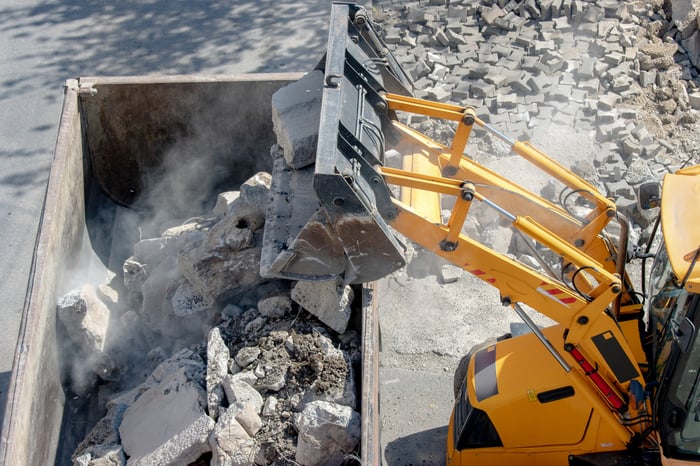The circular economy revolutionises the way we interact with materials, giving them a new life and addressing the current unsustainable speed of production and consumption. In a world where natural resources are finite, it is necessary to adopt a more conscious and sustainable approach, which is why the circular economy emerges as an effective solution to this challenge.
In contrast to continuous extraction and production, the circular economy proposes a closed cycle of reuse, recycling and regeneration of existing materials. This not only decreases the dependence on natural resources but also reduces waste generation, thus promoting a positive impact on the environment, the economy, and society as a whole.
In the field of construction, the circular economy challenges the traditional paradigm of using materials in a linear way and promotes a more holistic approach. Instead of considering materials as single-use resources, the aim is to maximize their lifespan through reuse, recycling, and regeneration. This involves not only the incorporation of recycled materials in construction, but also the design of buildings that facilitate dismantling and the recovery of components for future projects.
The 9 Rs of the circular economy in construction
Transitioning from a linear to a circular economy implies increasing circularity and applying the 9 Rs, which can be divided into three blocks depending on their focus. From rejecting unnecessary products to reusing and recycling materials, each of these actions significantly contributes to waste reduction, resource conservation, and climate change mitigation:
Optimization in the use and manufacturing of products:
- Refuse: Eliminate the need for a product by abandoning its function or replacing it with different alternatives.
- Rethink: Make the use of the product more intensive, for example, by sharing it.
- Reduce: Increase efficiency in the manufacturing or use of the product, thereby reducing the consumption of natural resources and materials.
Extension of the product's and its components' lifespan:
- Reuse: Allow another consumer to use a product in good condition that we no longer need.
- Repair: Repair and maintain a damaged product so that it can continue to be functional.
- Refurbish: Renovate an old product to update it and extend its useful life.
- Remanufacture: Reuse parts of a discarded product in the manufacture of a new one with the same function.
Effective application of materials:
- Recycle: Process the materials to obtain products of equal or lesser quality.
- Recover: Incinerate materials with the aim of energy recovery.
ISO 20887 and the concept DfD / A
The most important standard currently regulating the circular economy in construction is UNE-ISO 20887:2023. This is the standard on'Sustainability in buildings and civil engineering works; Design for dismantling and adaptability; Principles, requirements and guidelines'.
The central concept embodied in ISO 20887 is DfD/A, i.e. Design principles for dismantling and adaptability. This concept is central to sustainable development, and its objectives are to reduce or avoid waste generation, as well as to increase resource efficiency. DfD/A should be applied from the early stages of planning and designing the building.
This concept and consequent regulation arise from the fact that traditional assembly processes do not take into account the deconstruction of the building itself, so materials are usually not recovered at the end of the building's useful life, but instead become waste that is transported to landfills.
Buildings constructed with design principles for dismantling and adaptability incorporate pre-construction methods for the recovery of specific products and materials. In addition, they adapt to substantial changes in their environment and context, such as demographic, social and economic conditions, as well as changes in the physical needs of their occupants.
ISO 20887 provides the regulatory framework for DfD/A and all the key issues to be considered by the different actors involved in the sector, in particular the designers involved in the building construction in question. The standard is applicable to all types of buildings and civil engineering works.
1. Principles on the dismantling capacity of built assets
 These principles focus on ensuring that structures and components are designed in a way that facilitates their dismantling, reuse, and adaptability throughout their useful life.
These principles focus on ensuring that structures and components are designed in a way that facilitates their dismantling, reuse, and adaptability throughout their useful life.
1. Accessibility of components and facilities - The aim is to ensure that components and building systems are accessible for maintenance, repair and dismantling. This implies designing spaces and accesses that allow easy access to all parts of the building.
2. Independence of the different parts, components, modules and systems - The different elements that make up the structure must be independent of each other, so that they can be dismantled and replaced individually.
3. Finishes - It is recommended to avoid the use of finishes or materials that make dismantling or reuse of components difficult.
4. Construction details that encourage reuse, recycling, refurbishment, reconditioning and part replacement - Building design should encourage the possibility to reuse, recycle, refurbish and replace parts or components, thus promoting the circular economy and waste reduction.
5. Simplicity of elements or components - It is recommended to use simple and easily identifiable construction elements and components, which facilitate their dismantling and handling during the reuse or recycling process.
6. Standardisation: parts standardisation - Standardisation of parts and components facilitates interoperability and parts substitution, promoting efficiency in the dismantling and reuse process.
7. Ease of dismantling - The design should prioritise ease of dismantling of elements and components, using joining and fixing systems that allow them to be separated without damaging the materials.
8. Principle of adaptability - The structure should be designed in such a way that it can adapt to future changes in needs, uses or technologies, thus prolonging its service life and reducing the need for new construction.
9. Versatility - The ability to change the use of the building without significant structural modifications increases its versatility and value over time.
10. Convertibility - Consideration should be given to the possibility of converting parts or components of the structure to meet new functional or aesthetic requirements, thus extending its service life and relevance over time.
11. Expandability - The structure should be designed with the possibility of expansion to accommodate future growth or modifications, thus avoiding premature obsolescence and the need for additional construction.
These principles constitute a fundamental guide for professionals involved in the design and construction of buildings and civil engineering works, thus contributing to the promotion of more sustainable and environmentally responsible practices.
2. Actions for improving circularity
The improvement of circularity in the project, work, and waste management is a crucial aspect to promote sustainability in the building industry. This approach involves the implementation of a series of actions and measures throughout the entire building life cycle or civil engineering work, from the design stage to waste management.
Considerations in the project
1. Evaluation of the principles of dismantling
- A detailed evaluation of the principles of dismantling must be carried out during the design phase of the project. This involves analysing the ease of dismantling of the elements and construction components, as well as their capacity for reuse, recycling, and refurbishment.
2. Review of construction details
- During the design phase and planning of the project, the construction details must be reviewed to ensure they comply with the principles of dismantling and circularity. This includes the selection of materials and construction systems that facilitate the dismantling and recovery of materials.
3. Dismantling plan
- A detailed dismantling plan must be developed that documents the procedures and strategies for the dismantling of the structure and the management of the recovered materials. This plan, also known as the building book, must be prepared during the design phase and updated throughout the building life cycle.
4. Materials passport
- A material passport system must be implemented to document the composition and properties of the materials used in the building construction. This passport facilitates the identification and recovery of materials during the dismantling and waste management process.
5. Maintenance plan
- A preventive and corrective maintenance plan must be established to ensure the durability and good condition of the materials and construction components over time.
6. Procedure for managing information about the building's lifespan
- A procedure for managing information about the building's lifespan must be implemented, which includes the collection and updating of relevant data on the condition and performance of materials and construction systems.
7. BIM model
- The implementation of a building information model (BIM) facilitates the integrated management of building information, including design, construction, maintenance and dismantling aspects. The BIM model allows visualizing and analysing the building as a whole, identifying opportunities to improve circularity and resource use efficiency.
Actions during the work
1. Change control
- A change control system must be established to record and manage modifications made during the construction phase. This ensures consistency between the initial design and the execution of the work, minimizing negative impacts on the project's circularity.
2. Information management tracking
- During the work, continuous monitoring of the management of information related to the project must be carried out, including documentation of the materials used, the changes made, and the planned dismantling procedures. This ensures the consistency and integrity of the information throughout the building life cycle.
Other considerations
Life cycle analysis (LCA) - A life cycle analysis (LCA) must be carried out to assess the environmental impact of the materials and processes used in the construction of the building. This allows identifying opportunities to improve circularity and reduce waste generation throughout the building life cycle.
Implementation of waste prevention measures - Waste prevention measures must be implemented during the design phase and project planning. This includes the selection of materials and construction systems that generate less waste, as well as the optimization of construction processes to reduce the amount of waste generated.

Segregated collection of materials prepared for reuse
3. Supporting documentation
The supporting documentation provides a solid foundation for informed decision-making and performance evaluation in terms of sustainability and circularity. The key documents that support the sustainable management of the project and the work are detailed below:
Documentation to be provided in the project phase:
- Customer Specifications Document
- BIM model
- LCA project
- LCC project
- Adaptability Plan
- Deconstruction plan (dismantling plans, dismantling sequence)
- Passport materials (design)
- Maintenance plan (connection details)
Documentation to be provided during the construction phase:
- Materials Passport (construction tracking)
- Support in project monitoring
- LCA of the finished building
- LCC of the finished building
Other documentation to provide:
- Communication Plan
- Information management procedure, data digitization - BIM
In conclusion, the circular economy in construction not only reduces environmental impact by minimising resource extraction and waste generation, but also fosters innovation in the design and construction of more resilient and energy-efficient infrastructure. The ISO 20887 constitutes the regulatory framework for the circular economy in construction, setting the guidelines to be followed by all actors in the sector.


